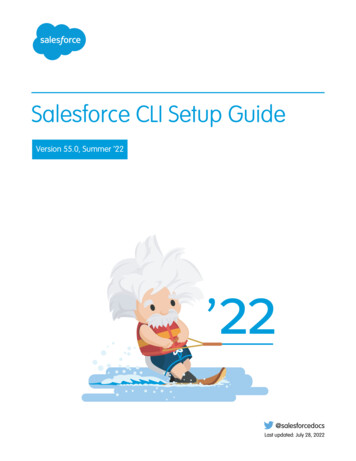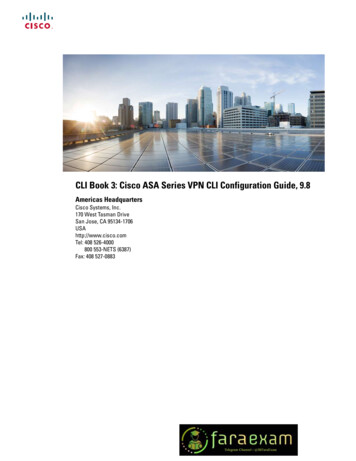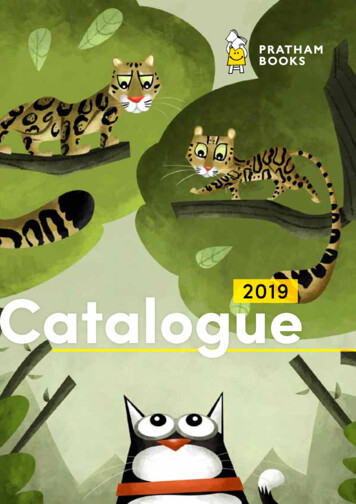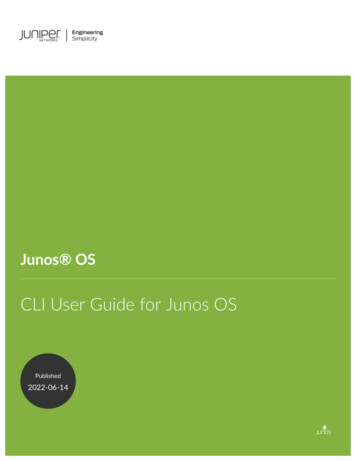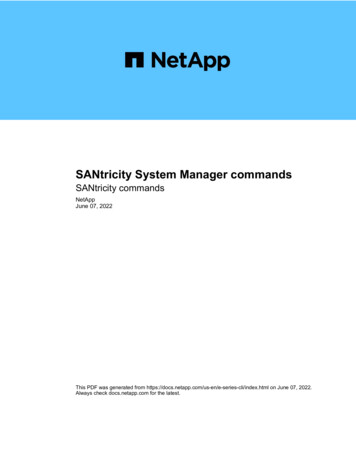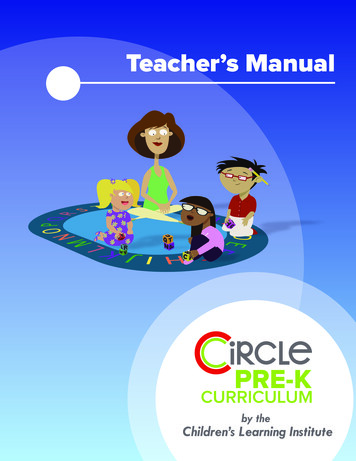
Transcription
Teacher’s Manual
CiRCLePRE-KCURRICULUMby theChildren's Learning Institute
Children’s Learning InstituteMcGovern Medical School at UTHealth7000 Fannin Street Suite 2300 Houston, Texas 77030E: CIRCLEPreKCurriculum@uth.tmc.eduW: CLIsolutionsgroup.org
Table of ContentsCircle Pre-K Curriculum Overview .1THE CIRCLE PRE-K CURRICULUM FEATURES.1CURRICULUM COMPONENTS .1Scope and Sequence .2Theme Guide .5Suggested Theme Sequence .6Downloadable Resources .8Understanding Icons.8Lesson Planning .9Steps for Lesson Planning.9Skill Domain Areas Addressed . 11ALPHABET KNOWLEDGE . 11How Should Alphabet Knowledge Be Taught? . 11Letter Wall . 11Informal Alphabet Activities and Games . 12Targeted Letter Instruction . 13Sequence of Letter Lessons . 14BOOK AND PRINT READING . 15Book Reading Experiences. 16Print Reading Experiences . 17FINE ARTS . 17LANGUAGE AND COMMUNICATION . 18Oral Language . 18Building Language and Communication withthe Complete Curriculum. 19MATHEMATICS .20Formal Mathematics Instruction.20Informal Mathematics Experiences. 21Math in Centers . 21 2021 The University of Texas Health Science Center at Houston. All rights reserved.III
PHONOLOGICAL AWARENESS . 21Developmental Timeline . 22PHYSICAL DEVELOPMENT. 23Motor Skills . 23Personal Health and Safety. 25SCIENCE. 26SOCIAL AND EMOTIONAL DEVELOPMENT . 27Self-Concept . 28Self-Regulation . 29Relationships with Others/Social Awareness Skills . 29SOCIAL STUDIES . 29TECHNOLOGY. 31Benefts and Guidelines. 31Experiences with Technology. 32Limitations. 33WRITING. 34Instructional Approaches. 34Developmental Writing Stages. 35Fine Motor Development. 37FAMILY ENGAGEMENT . 37Bringing the Curriculum into the Home . 37Family Engagement Toolkit. 38The Structures and Processes of ClassroomManagement. 40RELATIONSHIPS . 40RULES, ROUTINES, & PROCEDURES . 41Classroom Rules . 41Routines and Procedures . 42Tools for Implementing Classroom Routines and Procedures. 42Implementing Rules, Routines, and Procedures. 46PHYSICAL ENVIRONMENT . 48Room Arrangement . 48Print-Rich Environment.50IV 2021 The University of Texas Health Science Center at Houston. All rights reserved.
Learning Settings and Opportunities. 53CIRCLE TIME . 53Structure. 54Types of Experiences . 54SMALL GROUP TIME . 54Structure. 55CENTER TIME .56Structure.56Center Experiences.56TRANSITION TIME . 57Structure. 57Types of Experiences . 57SUPPORTING LEARNERS IN ALL SETTINGS .59Engaging, Hands-on Experiences.59Scafolding.59Intentional Teaching. 61English Learners. 62EFFECTIVE PRACTICES. 62Create a Safe Environment for Language Learning . 62Providing Academic Support. 62BUILDING VOCABULARY AND EARLY LITERACY SKILLS. 63LEVERAGING HOME LANGUAGE PROFICIENCY .65Special Needs.66UNDERSTANDING SPECIAL NEEDS .66Assessment .69CIRCLE PROGRESS MONITORING . 70Appendix . 75References . 87 2021 The University of Texas Health Science Center at Houston. All rights reserved.V
VI 2021 The University of Texas Health Science Center at Houston. All rights reserved.
Circle Pre-K Curriculum OverviewTHE CIRCLE PRE-K CURRICULUM FEATURES:y Comprehensive coverage of skill domains supporting cognitive andsocial and emotional developmenty Balance of teacher-directed lessons and child-initiated activitiesy Daily playful and purposeful experiences across whole group, small group,and center timey Lesson scripting that follows a teaching and learning cycley Flexible Theme Guides for building language and background knowledgethrough meaningful and relevant experiencesy Scafolds and teacher tips for modifying lessonsy Authentic videos of lessons in action (available through the onlineCIRCLE Activity Collection)y English and Spanish versionsCURRICULUM COMPONENTSThe CIRCLE Pre-K Curriculum is comprised of a variety of resources designed to supportyour weekly planning and delivery of instruction.y Scope and Sequencesy Theme Guidesy Supplemental resources1
The CIRCLE Pre-K Curriculum includes Scope and Sequences and Theme Guidesfor addressing all aspects of the prekindergarten day throughout the school year.These components are supported by a comprehensive bank of high-quality lessonshoused in the CIRCLE Activity Collection (CAC) on CLI Engage. Lessons are scripted,providing guidance for teachers to move through a cycle of modeling, guided practice,and independent practice. Many of the lessons are accompanied by videos showingdemonstrations of the lessons in authentic settings. Lessons also include Teacher Tips,which provide ideas for extensions and changes, and Scafolds, which suggest ways toadjust lessons based on children’s individual needs. These ideas for how to diferentiateinstruction help teachers deliver lessons that are appropriate and targeted for thechildren in their group or class, whether children are three- or four-years-old, or needmore foundational or more advanced support.The Scope and Sequences and Theme Guides work together to provide weeklyinstruction that comprehensively supports the cognitive, social, and emotionaldevelopment of prekindergarten children. As teachers use these resources to planlessons for a week, they have the ability to select fewer lessons to teach, and to adjusthow quickly they move from one week of content to the next. This fexibility will beespecially helpful for teachers with more three-year-olds, who may move through thecurriculum more slowly, and for teachers of half-day programs, who will include fewer ofthe curriculum components in their lesson plans.Scope and SequenceThe Scope and Sequence is the primary curriculum component. It addresses skills ina sequence that ensures progression of skills across the school year. The Scope andSequences cover 35 weeks of instruction. Lessons are organized into the followingcategories with other skill domains integrated:y Book & Print Readingy Phonological Awarenessy Language & Communicationy Alphabet Knowledgey Writingy Mathematicsy Sciencey Social & EmotionalDevelopment2 2021 The University of Texas Health Science Center at Houston. All rights reserved.
See the Skill Domain Areas Addressed section of this Teacher’s Manual for detailedinformation on each of the above categories to learn the skills addressed and theprogression of skills.3
The Scope and Sequence indicates the names of lessons designated for the week.Lesson names are always indicated in colored font. You can view the detailed lesson atCLIEngage.org or in the printed Scope and Sequence book.Sculpting AnimalsHead StartAlignmentPreK GuidelinesAlignmentKindergarten TEKSAlignmentGoal P-PMP 3. Childdemonstrates increasingcontrol, strength, andcoordination of smallmuscles.II.D.4. Child uses a largespeaking vocabulary,adding several newwords daily.VIII.A.1. Child uses avariety of art materialsand activities forsensory experience andexploration.IX.B.1. Child showscontrol of tasks thatrequire small-musclestrength and control.§117.102(b)(2)(C) use avariety of materials todevelop manipulativeskills while engagingin opportunities forexploration throughdrawing, painting,printmaking, constructingartworks, and sculpting,including modeled forms.Language & CommunicationChildren will explore with clay to create an animalwhile learning the words for diferent techniques.Materials craft sticks modeling dough or clay pictures of animalsPreparationDivvy up the clay onto paper plates for each child. Each child needs enough to createan animal. Have craft sticks available, one for each child, to use for cutting. Gather picturesof diferent animals, for example, octopus, cat, mouse, turtle, caterpillar, for each group ofchildren.Video demonstration available at CLIEngage.orgIntroduce“Today you are going to use clay to create an animal using your hands. As you createyour animals you will roll, pinch, squeeze, pat, and cut the clay. I will show you how todo all these things as you create your animal.” Hold up a ball of clay three inches indiameter. Use the same ball of clay to model each action.“Rolling looks like this.” Model. “What is this?” Choral response: “Rolling.” 2020 The University of Texas Health Science Center at Houston. All rights reserved.27Note: Lesson names are indicated on theScope and Sequence. Fully detailed lessonsare available at CLIEngage.org and in theprinted Scope and Sequence books.The fexible design of the Scope and Sequence allows you to select the day of the weekand setting (whole or small group) for each lesson. Lessons can be used multiple timesacross the week as concepts are introduced, practiced, and reinforced. You determinewhich lessons to repeat and the number of times. The table below describes the threecategories of lessons indicated on the Scope and Sequence.4TargetLessonsUse each Target Lesson with all children one or more times during theweek to ensure skill coverage and progression. Repeat lessons acrossthe week as needed or desired.Step It UpUse these optional lessons with children who might beneft from morechallenging tasks than those included in the Target Lessons.AdditionalLessonsAdditional Lessons are Target Lessons from previous weeks in thecurriculum. Use these optional lessons to address a greater range ofskills and to revisit previously taught lessons. Repeat lessons acrossthe week as needed or desired. 2021 The University of Texas Health Science Center at Houston. All rights reserved.
A Family Engagement section is also included in every Scope and Sequence. Theseactivities can be provided to families as a way to enhance the family-school partnershipand encourage families to engage in playful learning experiences. Through theseactivities, families become involved in supporting the skills children are learning thatweek in school. Learn more in the Family Engagement section of this Teacher’s Manual.Theme GuideTheme Guides work in partnership with the Scope and Sequence to organizemeaningful, hands-on lessons and experiences around a common theme. While theScope and Sequence ensures systematic coverage of all skill domains, the ThemeGuide enhances the Scope and Sequence. There are ten themes designed to addressconcepts and experiences that build important background and content area knowledge.In addition to supporting the skill domains from the Scope and Sequence, Theme Guidesaddress:y Fine Artsy Physical Developmenty Social Studiesy TechnologyUsing a Theme Guide in conjunction with the Scope and Sequence ensurescomprehensive coverage of all skill domain areas while addressing all aspects of theprekindergarten schedule.Within each theme is a set of topics, or subthemes. Each topic addresses approximatelyone week of activities and lessons for all aspects of the prekindergarten day. Topics arefexible, allowing teachers to spend more or less than one week on a topic, if desired.Welcome to Pre-K! is an integrated Scope and Sequence and Theme Guide designedspecifcally to address the particular needs of young children during the frst two weeksof prekindergarten.Integrated Scope and Sequenceand Theme GuideWelcome to Pre-K!TopicsWeeksMy SchoolWeek 1My FriendsWeek 2Beginning with week 3 of school, teachers can use themes in any order or follow thesuggested sequence provided below.5
Suggested Theme SequenceThemeTopicsScope andSequenceI’m Me! I’m Special!My Home and FamilyMy Amazing BodyMy Five SensesMy Important FeelingsWeeks 3-6All Around My CommunityPlaces in My CommunityPeople and Jobs in My CommunityGetting Around in My CommunityConstruction in My CommunityWeeks 7-10It’s Harvest Time!Signs of Fall HarvestHarvesting CropsBringing the Harvest HomeWeeks 11-13The Sky Above MeThe Cloudy SkyThe Sunny SkyThe Night SkyThe Seasonal SkyWeeks 14-17Animals All AroundAnimal Bodies and MovementsAnimal Homes and HabitatsAnimal Babies and DietsAnimal Adaptations and HabitsWeeks 18-21I’m Healthy! I’m Safe!My Safe and Active BodyMy Safe and Healthy Eating HabitsMy Healthy Body and TeethWeeks 22-24Get Moving!Moving Through AirMoving on LandMoving on WaterWeeks 25-27The Earth Around MeLand All AroundPlants All AroundWater All AroundCaring All AroundWeeks 28-31Creepy Crawly CrittersCritter Bodies and MovementsCritter Homes and HabitatsCritter Life Cycle and DietCritter Adaptations and HabitsWeeks 32-35Theme Guides are organized into three sections to support lesson planning andimplementation. The three sections are described below.6 2021 The University of Texas Health Science Center at Houston. All rights reserved.
Whole Group andSmall Group ThemeLessonsAdditional whole group and small group lessons whichmay not be included in the Scope and Sequence.These supplemental lessons appear in the Theme Guidebecause they directly connect to theme concepts.Theme ExtendersSuggestions for ways to integrate theme vocabulary,read aloud books, and activities with the Scope andSequence activities and lessons.Learning CentersRecommendations for adding thematic materials andactivities to supplement or replace your classroom’sexisting center materials and activities.Like the Scope and Sequence, the Theme Guide indicates the names of lessonsdesignated for the topic. Lesson names are always indicated in colored font. You canview the detailed lesson at CLIEngage.org or in the printed Theme Guide book.I Spy an AnimalChildren will listen to clues to determine the object being described.Head StartAlignmentGoal P-LC 2. Childunderstands andresponds to increasinglycomplex communicationand language fromothers.PreK GuidelinesAlignmentII.A.3. Child showsunderstanding of thelanguage being spokenby teachers and peers.Kindergarten TEKSAlignment§110.2(b)(3)(C) identifyand use words thatname actions; directions;positions; sequences;categories such ascolors, shapes, andtextures; and locations.Materials several objects, pictures, or photographs that relate to a theme, such as zoo animalsPreparationBe prepared to have a variety of items/pictures that ft within the same theme. Select themesthat are familiar to children. This example uses zoo animals.Video demonstration available at CLIEngage.orgIntroduce“Today we will play a game called I Spy. In this game, you will need to listen to someclues in order to guess what is being described.”Place selected objects on the table. Review each animal to be sure the children knowits name.”Model and Explain“Here you see several animals. I will go frst so that you can see how the game is played.I will choose one of the animals by using my eyes. Once I have chosen the animal, I willgive you some clues of the thing ‘I Spy.’”“I spy an animal that is black and white and looks like a horse. What is it?”Children respond.“Right, it’s a zebra! A zebra is black and white and it looks like a horse.”Additional clues may need to be given if children are unable to guess correctly the frst time.24 2020 The University of Texas Health Science Center at Houston. All rights reserved.Refer to the overview section at the front of each Theme Guide for additional informationto support implementation of particular themes.7
Downloadable ResourcesPicture cards or workmats are included with some lessons. The availability of theseresources is indicated by a PDF icon in the Materials section of the digital lesson.Curriculum users can download and print these resources as needed.Some lessons require materials not included as supplemental resources. In these cases,directions are provided for creating the resource.Understanding IconsIdentifes lessons with English video demonstrations. Visit the digital lesson in theCIRCLE Activity Collection at CLIEngage.org to view these lessons in action withchildren.Identifes lessons with Spanish video demonstrations. Visit the digital lesson in theCIRCLE Activity Collection at CLIEngage.org to view these lessons in action withchildren. English videos may be available when Spanish videos are not. To view thelesson in English, visit the Spanish digital lesson, then click the “View Activity inEnglish” button.Indicates lessons recommended for use in a small group setting. Most lessons areappropriate in either whole group or small group settings. Teachers determinethe setting based on children’s needs, materials, and classroom managementconsiderations.Indicates notes or tips for preparing and delivering lessons or activities.Reminds you to select and use a Theme Guide in conjunction with the Scope andSequence.Indicates songs and rhymes found in The Complete Book of Rhymes, Songs, Poems,Fingerplays, and Chants by Jackie Silberg and Pam Schiller for English curriculumusers or in The Bilingual Book of Rhymes, Songs, Stories, and Fingerplays por PamSchiller, Rafael Lara-Alecio, y Beverly J. Irby for Spanish curriculum users. Most songsand rhymes can also be found through an online search.8 2021 The University of Texas Health Science Center at Houston. All rights reserved.
Lesson PlanningThis section provides lesson planning guidance for new users of the curriculum. Ateacher’s approach to lesson planning is a unique process informed by a variety offactors, including the daily schedule and children’s developmental needs. Curriculumcomponents fexibly meet the needs of full- and half-day prekindergarten programs, aswell as those serving three- and four-year-old children.The Scope and Sequence and Theme Guide are used together to comprehensively planhow children will engage in whole group (circle time), small groups, and centers duringa week. Teachers can easily plan for a full-day schedule, while the fexible design allowshalf-day programs to select fewer lessons and activities when planning. To address thediferent developmental and instructional needs of the children, teachers can select fromTarget Lessons, Additional Lessons, and Step It Up! lessons. Within each lesson, TeacherTips can adjust or extend the activity and Scafolds can simplify the task or supportunderstanding. Teachers should plan each week using the fexible features of the Scopeand Sequence and Theme Guide to meet the specifc needs of the children in the class.Steps for PlanningStep 1: Gather Materials1. Scope and Sequence for the week you are planning—for example, use theWeek 3 Scope and Sequence for the third week of the year2. Theme Guide—a recommended theme sequence is included in the ThemeGuide section of this Teacher’s Manual3. Any preferred lesson plan document or tool—a sample template is included touse or modify as needed4. Assessment data—formal and informal data are critical considerationsthroughout the planning process and should be considered in each stepStep 2: Review Scope and Sequence LessonsIdentify the skills addressed this week. Look at the lessons indicated in colored fontand briefly review the detailed/scripted version of each lesson. For each lesson,determine the following: Will I use the lesson?Note: Use of all Target Lessons ensures comprehensive skill coverage andprogression. Lessons in the Step It Up! and Additional Lessons sections areoptional. If you will use the lesson:o Will the lesson be used with all children or only some children?o Will the lesson take place in whole group or small group(s)?Step 3: Plan Using the Scope and SequenceAdd Scope and Sequence lessons to your lesson plan according to decisions made inStep 2.9
Step 4: Review Theme Guide Lessons and ActivitiesReview the three sections for the Topic: 1) Whole Group and Small Group ThemeLessons, 2) Theme Extenders, and 3) Learning Centers.Determine the following: Will I use the lesson or activity? Will it take place in whole group or small group(s)?Note: Demonstrate center activities during whole group or small group(s)before adding to centers.Step 5: Plan Using the Theme Guide Add Theme Guide lessons and activities to your lesson plan according todecisions made in Step 4. Document any adaptations you will make to Scope and Sequence lessons inorder to incorporate the theme into your lessons.Step 6: Review and ReflectReview the lesson plan carefully to ensure all components of the school day have beenaddressed. For example: Are all learning domains addressed? Is each component of the daily schedule accounted for? Is it necessary to back up to earlier lessons for any skills?Note: This may apply to the whole class or to particular children who maybenefit from targeted small group instruction. Have you determined which transitions you will use? Do you know what books and materials are needed?These steps provide a general overview of how to use each component of the CIRCLEPre-K Curriculum to plan for a week of instruction. Efective planning is a detailedprocess that includes planning forteacher-led and child-initiatedexperiences, preparing and gatheringmaterials, and adjusting the physicalenvironment to support language andlearning.Themes are most successful whenteachers begin to plan for them inadvance. Identify your upcomingtheme and carefully review the ThemeGuide to identify resources andmaterials that may take time to gatheror prepare. Theme Guides oferdetail
Scope and Sequence . The . Scope and Sequence. is the primary curriculum component. It addresses skills in a sequence that ensures progression of skills across the school year. The . Scope and Sequences. cover 35 weeks of instruction. Lessons are organized into the following categories with other skill domains integrated: yBook & Print Reading
